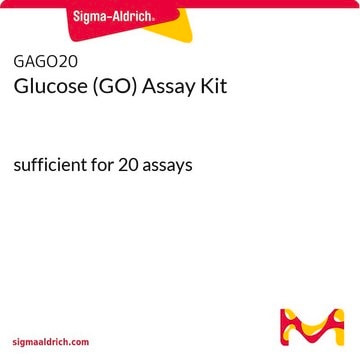Products may be shipped at a different temperature than the recommended long-term storage temperature. If the product quality is sensitive to short-term exposure to conditions other than the recommended long-term storage, it will be shipped on wet or dry-ice. If the product quality is NOT affected by short-term exposure to conditions other than the recommended long-term storage, it will be shipped at ambient temperature. As shipping routes are configured for minimum transit times, shipping at ambient temperature helps control shipping costs for our customers. For more information, please refer to the Storage and Transport Conditions document: https://www.sigmaaldrich.com/deepweb/assets/sigmaaldrich/marketing/global/documents/316/622/storage-transport-conditions-mk.pdf
推荐产品
用途
sufficient for 100 colorimetric or fluorometric tests
应用
cosmetics
food and beverages
检测方法
colorimetric
fluorometric
相关疾病
endocrinological disorders, diabetes; cancer
储存温度
−20°C
一般描述
适用性
原理
警示用语:
Danger
危险声明
危险分类
Resp. Sens. 1 - Skin Sens. 1
储存分类代码
10 - Combustible liquids
闪点(°F)
188.6 °F - closed cup
闪点(°C)
87 °C - closed cup
历史批次信息供参考:
分析证书(COA)
商品
本页面介绍了一篇有关瓦博格效应的文章,以及其如何能够在正常氧气水平下,增强肿瘤细胞中葡萄糖向乳酸的转化。Otto Heinrich Warburg在1924年证明,癌细胞显示出对糖酵解的依赖性增加,以满足他们的能量需求,无论是否有充足的氧气存在。
Warburg effect enhances glucose to lactate conversion in tumor cells, regardless of oxygen levels; impacting cancer metabolism since 1924.
-
How is shipping temperature determined? And how is it related to the product storage temperature?
1 answer-
Helpful?
-
-
How can I determine the shelf life / expiration / retest date of this product?
1 answer-
If this product has an expiration or retest date, it will be shown on the Certificate of Analysis (COA, CofA). If there is no retest or expiration date listed on the product's COA, we do not have suitable stability data to determine a shelf life. For these products, the only date on the COA will be the release date; a retest, expiration, or use-by-date will not be displayed.
For all products, we recommend handling per defined conditions as printed in our product literature and website product descriptions. We recommend that products should be routinely inspected by customers to ensure they perform as expected.
For products without retest or expiration dates, our standard warranty of 1 year from the date of shipment is applicable.
For more information, please refer to the Product Dating Information document: https://www.sigmaaldrich.com/deepweb/assets/sigmaaldrich/marketing/global/documents/449/386/product-dating-information-mk.pdfHelpful?
-
-
What is the formula for the MAK064D Lactate standard?
1 answer-
The standard provided in the MAK064-1KT Lactate Assay Kit is L-Lactic acid sodium salt (CAS 867-56-1) dissolved in water. It contains no other components or cofactors.
Helpful?
-
-
Since the L-(+)-Lactate standard is not a pure solution of sodium L-(+)-Lactate in water or buffer, which are the cofactors present in the standard?
1 answer-
The standard provided in this kit is L-Lactic acid sodium salt (CAS 867-56-1) dissolved in water. There are no other components or cofactors present in the standard.
Helpful?
-
-
What is the concentration range of lactate for this? The description says typical sensitivity is 0.001 - 10 mM, but in the product info the standard curve for colorimetric detection appears to go to a max. concentration of 0.0002µM (10nmol in 50µL sample)
1 answer-
The lower limit of detection is calculated by dividing the lowest concentration standard by the maximum sample volume. The higher limit of detection is determined by dividing the highest concentration standard by the minimum sample volume.
For the higher limit of detection, take the 10 nmol standard and divide by 1 uL to get 10 mM. For the lower limit of detection, take 0.02 nmol and divide by 50 uL to get 0.0004 mM. We have reached out to our vendor to discuss the range calculation further, as it seems there is some conflicting information.
Helpful?
-
-
Can this kit be used on conditioned media containing phenol red?
1 answer-
If the sample being measured is the cell culture supernatant, the required volume is 20 uL. This is diluted with a total volume of 100 uL of the various kit reagents. The presence of phenol red may impact the results. It would be up to the end user to determine suitability.
Helpful?
-
-
On which enzymatic reaction is this kit based? Does pyruvate in the sample interfere with the assay?
1 answer-
This kit utilizes lactate oxidase to measure lactate. In sufficient amounts pyrivate may impact the results. This can be corrected by subtracting any background from the blank value. See page 3 in the kit protocol provided in the link below:
https://www.sigmaaldrich.com/deepweb/assets/sigmaaldrich/product/documents/411/763/mak064bul.pdfHelpful?
-
-
What is the Department of Transportation shipping information for this product?
1 answer-
Transportation information can be found in Section 14 of the product's (M)SDS.To access the shipping information for this material, use the link on the product detail page for the product.
Helpful?
-
-
Can I make up my own Lactate standard to use with Product MAK064, Lactate Assay kit?
1 answer-
Unfortunately, no. If you run the 100 mM L-(+)-Lactate standard (MAK064D) that comes with the kit, you should get good results. However, if you just use, for example, a solution of sodium L-(+)-lactate dissolved in water or buffer, you probably won't get good results. There are cofactors present in biological samples and in the L-(+)-Lactate standard that comes with the kit (which is not a pure solution of sodium L-(+)-Lactate in water or buffer). If such a "homemade" standard solution were to be spiked with a biological sample or the kit standard, the calculations would be more complicated, but the assay should work.
Helpful?
-
Active Filters
我们的科学家团队拥有各种研究领域经验,包括生命科学、材料科学、化学合成、色谱、分析及许多其他领域.
联系技术服务部门


